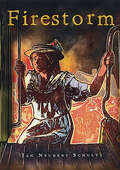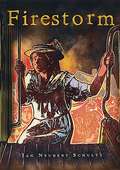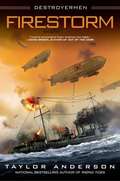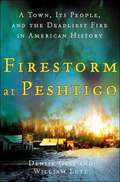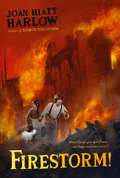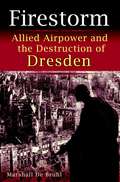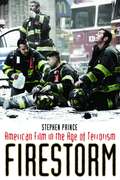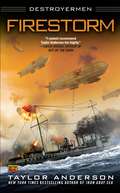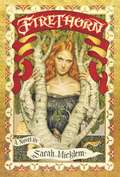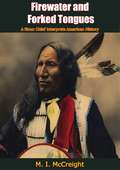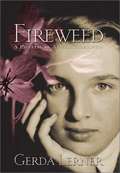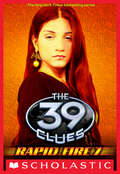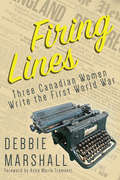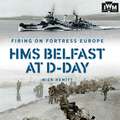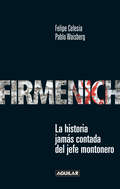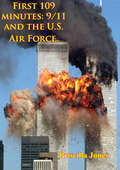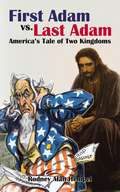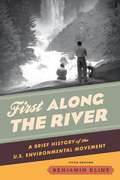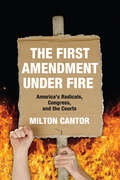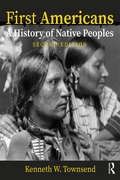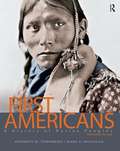- Table View
- List View
Firestorm (Adventures In Time Ser.)
by Janet Neubert SchultzIt's September 1, 1894, and 13-year-old Maggie Grant and her family are about to face a terror like none they've ever experienced. Having recently moved to the newly constructed town of Hinckley, Minnesota, they are caught in the path of one of the deadliest forest fires in history. Separated from her brothers and forced to flee, Maggie begins a harrowing train ride to Duluth, Minnesota, as the fire rages around her. Once there, Maggie must make a choice--should she stay in Duluth, or can she face her fears and return to what remains of Hinckley to search for her brothers?
Firestorm (Adventures In Time Ser.)
by Janet Neubert SchultzIt's September 1, 1894, and 13-year-old Maggie Grant and her family are about to face a terror like none they've ever experienced. Having recently moved to the newly constructed town of Hinckley, Minnesota, they are caught in the path of one of the deadliest forest fires in history. Separated from her brothers and forced to flee, Maggie begins a harrowing train ride to Duluth, Minnesota, as the fire rages around her. Once there, Maggie must make a choice--should she stay in Duluth, or can she face her fears and return to what remains of Hinckley to search for her brothers?
Firestorm (Destroyermen, Book #6)
by Taylor AndersonIn Taylor Anderson's acclaimed Destroyermen series, a parallel universe adds an extraordinary layer to the drama of World War II. Now Lieutenant Commander Matthew Reddy and the crew of USS Walker find themselves caught between the nation they swore to defend and the allies they promised to protect .... The Allies and the Empire of New Britain Isles now stand united against the attacks of both the savage Grik and the tenacious Japanese. But Designated Supreme Commander of the Allied Forces Matt Reddy has a new foe to contend with: the Holy Dominion, a warped mixture of human cultures whose lust for power overshadows even the Grik's. Only a risky naval engagement and a desperate land battle can preserve freedom and prevent swift conquest by the Dominion. As open war rages across half the known world, more Japanese ships come through the time-space maelstrom the Americans call the Squall. One is a "Hell Ship" carrying survivors of encounters with Imperial Japan, which is growing even more ruthless in the face of looming defeat. Escorting it is a new state-of-the-art destroyer, the officers of which don't adhere to any rules of war. Fighting a desperate battle against the Dominion while on another front his friends face annihilation by the Grik, Reddy is plunged into a firestorm of loyalty, betrayal, and sacrifice. But nothing he endures can prepare him for a devastating new Grik weapon--a weapon that could destroy the Allies and the Empire once and for all ...
Firestorm at Peshtigo: A Town, Its People, and the Deadliest Fire in American History
by Denise Gess William LutzA riveting account of a monster firestorm - the rarest kind of catastrophic fire - and the extraordinary people who survived its wrath. On October 8, 1871 - the same night as the Great Chicago Fire - an even deadlier conflagration was sweeping through the lumber town of Peshtigo, Wisconsin, 260 miles north of Chicago. The five-mile-wide wall of flames, borne on tornado-force winds of 100 miles per hour, tore across more than 2,400 square miles of land, obliterating Peshtigo in less than one hour and killing more than 2,000 people. Firestorm at Peshtigo places the reader at the center of the blow-out. Through accounts of newspaper publishers Luther Noyes and Franklin Tilton, lumber baron Isaac Stephenson, parish priest Father Peter Pernin, and meteorologist Increase Lapham - the only person who understood the unusual and dangerous nature of this fire - Denise Gess and William Lutz re-create the story of the people, the politics, and the place behind this monumental natural disaster, delivering it from the lost annals of American history. Drawn from survivors' letters, diaries, interviews, and local newspapers, Firestorm at Peshtigo tells the human story behind America's deadliest wildfire.
Firestorm!
by Joan Hiatt HarlowTwo worlds collide when Poppy, a street orphan who makes a living by stealing, and Justin, the son of a jeweler who wants to prove his worth, meet and become friends. Poppy plans to change her thieving ways, but when Justin loses money at his father's jewelry store and Poppy is accused of stealing it, she flees back onto the streets. Justin insists on searching for her--just as the Great Chicago Fire of 1871 breaks out. Alternately narrated by Poppy and Justin, this is a gripping story of right and wrong, trust and forgiveness, and finding hope in the ashes of destruction.
Firestorm: Allied Airpower and the Destruction of Dresden
by Marshall De BruhlOn February 13 and 14, 1945, three successive waves of British and U.S. aircraft rained down thousands of tons of high explosive and incendiary bombs on the largely undefended German city of Dresden. Night and day, Dresden was engulfed in a vast sea of flame, a firestorm that generated 1,500-degree temperatures and hurricane-force winds. Thousands suffocated in underground shelters where they had fled to escape the inferno above. The fierce winds pulled thousands more into the center of the firestorm, where they were incinerated. By the time the fires burned themselves out, many days later, a great city-known as "the Florence on the Elbe"-lay in ruins, and tens of thousands, almost all of them civilians, lay dead.In Firestorm, Marshall De Bruhl re-creates the drama and horror of the Dresden bombing and offers the most cogent appraisal yet of the tactics, weapons, strategy, and rationale for the controversial attack. Using new research and contemporary reports, as well as eyewitness stories of the devastation, De Bruhl directly addresses many long-unresolved questions relating to the bombing: Why did the strike occur when the Allies' victory was seemingly so imminent? Was choosing a city choked with German refugees a punitive decision, intended to humiliate a nation? What, if any, strategic importance did Dresden have? How much did the desire to send a "message"-to Imperial Japan or the advancing Soviet armies-factor into the decision to firebomb the city?Beyond De Bruhl's analysis of the moral implications and historical ramifications of the attack, he examines how Nazi and Allied philosophies of airpower evolved prior to Dresden, particularly the shift toward "morale bombing" and the targeting of population centers as a strategic objective. He also profiles the architects and prime movers of strategic bombing and aerial warfare, among them aviation pioneer Billy Mitchell, RAF air marshal Sir Arthur "Bomber" Harris, and the American commander, General Carl Spaatz.The passage of time has done nothing to quell the controversy stirred up by the Dresden raid. It has spawned a plethora of books, documentaries, articles, and works of fiction. Firestorm dispels the myths, refutes the arguments, and offers a dispassionate and clear-eyed look at the decisions made and the actions taken throughout the bombing campaign against the cities of the Third Reich-a campaign whose most devastating consequence was the Dresden raid. It is an objective work of history that dares to consider the calculus of war.From the Hardcover edition.
Firestorm: American Film in the Age of Terrorism
by Stephen PrinceIt was believed that September 11th would make certain kinds of films obsolete, such as action thrillers crackling with explosions or high-casualty blockbusters where the hero escapes unscathed. While the production of these films did ebb, the full impact of the attacks on Hollywood's creative output is still taking shape. Did 9/11 force filmmakers and screenwriters to find new methods of storytelling? What kinds of movies have been made in response to 9/11, and are they factual? Is it even possible to practice poetic license with such a devastating, broadly felt tragedy? Stephen Prince is the first scholar to trace the effect of 9/11 on the making of American film. From documentaries like Fahrenheit 9/11 (2004) to zombie flicks, and from fictional narratives such as The Kingdom (2007) to Mike Nichols's Charlie Wilson's War (2007), Prince evaluates the extent to which filmmakers have exploited, explained, understood, or interpreted the attacks and the Iraq War that followed, including incidents at Abu Ghraib. He begins with pre-9/11 depictions of terrorism, such as Alfred Hitchcock's Sabotage (1936), and follows with studio and independent films that directly respond to 9/11. He considers documentary portraits and conspiracy films, as well as serial television shows (most notably Fox's 24) and made-for-TV movies that re-present the attacks in a broader, more intimate way. Ultimately Prince finds that in these triumphs and failures an exciting new era of American filmmaking has taken shape.
Firestorm: American Film in the Age of Terrorism
by Stephen PrinceIt was believed that September 11th would make certain kinds of films obsolete, such as action thrillers crackling with explosions or high-casualty blockbusters where the hero escapes unscathed. While the production of these films did ebb, the full impact of the attacks on Hollywood's creative output is still taking shape. Did 9/11 force filmmakers and screenwriters to find new methods of storytelling? What kinds of movies have been made in response to 9/11, and are they factual? Is it even possible to practice poetic license with such a devastating, broadly felt tragedy?Stephen Prince is the first scholar to trace the effect of 9/11 on the making of American film. From documentaries like Fahrenheit 9/11 (2004) to zombie flicks, and from fictional narratives such as The Kingdom (2007) to Mike Nichols's Charlie Wilson's War (2007), Prince evaluates the extent to which filmmakers have exploited, explained, understood, or interpreted the attacks and the Iraq War that followed, including incidents at Abu Ghraib. He begins with pre-9/11 depictions of terrorism, such as Alfred Hitchcock's Sabotage (1936), and follows with studio and independent films that directly respond to 9/11. He considers documentary portraits and conspiracy films, as well as serial television shows (most notably Fox's 24) and made-for-TV movies that re-present the attacks in a broader, more intimate way. Ultimately Prince finds that in these triumphs and failures an exciting new era of American filmmaking has taken shape.
Firestorm: Destroyermen
by Taylor AndersonBURNING WATERS Designated Supreme Commander of the Allied Forces, Matt Reddy must now contend with a new threat; the Dominion—humans whose lust for power matches the Grik. But even though the Grand Alliance recognizes the danger of the Dominion, it must deal with the land-based Grik first, leaving the Imperial navy—and USS Walker—with little assistance. As war rages, more Japanese ships come through the time-space maelstrom that the Americans call The Squall. One is a “Hell Ship,” carrying prisoners of an Imperial Japan that is growing ever more ruthless in the face of looming defeat. Escorting it is a new, state-of-the-art destroyer, whose officers recognize no rules of war. Fighting on two fronts, Reddy is plunged into a firestorm of loyalty, betrayal, and sacrifice. But nothing can prepare him for a devastating new Grik weapon—a weapon that could wipe out all who oppose them…
Firethorn (Firethorn Trilogy, Book #1)
by Sarah MicklemFirethorn, the first volume in an epic trilogy, is a stunning debut. Sarah Micklem has introduced an unforgettable heroine into the fantasy pantheon. Loving, reckless, and indomitable, Firethorn travels through an imaginary world as real as history and as marvelous as legend. Firethorn flees a life of drudgery to live alone in the forest, relying on her knowledge of herb lore to survive. She returns transformed, indebted to the god who saved her life, and blessed -- or cursed -- with uncanny abilities and a nagging sense of destiny. After a few nights of dalliance with Sire Galan, a high-caste warrior on his way to join the king's army, Firethorn seizes the chance to go with him, only to find she has exchanged one form of servitude for another. The army readies for war in the vast encampment of the Marchfield, where men prey on each other and women dare go nowhere alone. Among the lowborn harlots and the highborn dames of the camp, Firethorn learns to use her gifts as a healer, venturing into realms of dream and shadow. Desire drew Firethorn and Sire Galan together, but love binds them -- a love that has no place in the arrangement between a warrior and his sheath. When Galan makes a wager with disastrous consequences, Firethorn uses her gifts to intervene in his fate and learns just how hard it can be to tell honor from dishonor, justice from vengeance. Sarah Micklem has written an extraordinary tale -- at once magical and earthbound, beautiful and violent. She immerses readers in a remarkably imagined world where gods are meddlesome, the highborn uphold their privileges with casual brutality, and a woman's only recourse may be the strength she finds within.
Firewater and Forked Tongues: A Sioux Chief Interprets American History
by M. I. McCreightAs a dedicated Native American advocate since the age of 20, author Major Israel McCreight saw the sad plight of the Indians in the period following the Custer Fight and the Battle of Wounded Kane.This book, first published in 1947, is the account of the versions of U.S. history according to the old Sioux Chief, FLYING HAWK. Flying Hawk, who was a nephew of Sitting Bull and fought with Crazy Horse at Little Big Horn, dictated his narrative to McCreight, thus making this an account not from the perspective of “the white man”—but as it really happened…A fascinating read!
Fireweed
by Jill Paton WalshTwo teenage runaways who refuse to be evacuated from London struggle for survival amid the 1940 Blitz.
Fireweed: A Political Autobiography
by Gerda LernerAutobiography of pioneering women's historian focusing on her youth in Austria, escape from the Nazis involvement in radical politics and emigration to the U.S.
Fireworks (The 39 Clues: Rapid Fire #7)
by Clifford RileyThe last of seven brand new 39 Clues stories with an explosive secret revealed! The holidays can be hard for any family but they're particularly tough for the Cahills. Amy Cahill is exhausted from her training. Dan can't forget the tragedies he witnessed on the Clue hunt. Ian and Natalie Kabra are trying to enjoy the London festivities but it's hard without their parents. Even superstar Jonah Wizard is having trouble getting into the holiday spirit. Amy knows there's danger on the horizon but there's no reason they shouldn't enjoy themselves while they can. Taking advantage of their new fortune Amy and Dan book a private plane and jet off to fetch the other Cahills for a New Years none of them will ever forget.
Fireworks Tonight!
by Martha BrennerFrom the Book Jacket: Streams of sparks and sprays of colored stars light up the dark sky, thundering blasts echo all around ... FIREWORKS TONIGHT! For centuries man has been playing with fire with dazzling, sometimes dire, results-and few things have as much power to astound and intrigue us. Martha Brenner's research has turned up a wealth of fascinating information on the world of pyrotechnics. She covers the history of fireworks from the primitive firecrackers developed some 2000 years ago in China to the breathtaking special effects of today, the tragic accidents that have led to current laws regulating their use, the intriguing step-by-step development of a modern fireworks show from the drawing board to the actual shooting. How are fireworks made? Very carefully! And almost entirely by hand, because metal machinery produces heat and static electricity that could easily ignite an entire building full of explosives. Who makes fireworks? Most are manufactured by a handful of dynamic, devoted families that have passed on their tricks and trademarks for generations. Fireworks Tonight! gives us profiles of them and their particular pyrotechnical styles. How do fireworks work? Martha Brenner explains that, too-in clear, scientific detail. And there's more. Fireworks Tonight! includes a trip behind the scenes at a fireworks show, a visit to a manufacturing plant, a section on safety, a list of the 50 states' current laws on their sale and use, an illustrated spectators' guide-to help fire works fans tell a roman candle from a rocket and a list of notable fireworks facts: the biggest display in history, the loudest, the longest .. . Generously illustrated with over 60 photo graphs and prints, Fireworks Tonight! is a lively, accurate, and comprehensive introduction to a subject of universal appeal.
Firing Lines: Three Canadian Women Write the First World War
by Debbie Marshall Anna Maria TremontiRead between the front lines: The stories of three Canadian female journalists stationed in England and France during the First World War. Europe: 1914–18. Mary MacLeod Moore, a writer for Saturday Night Magazine, covered the war’s impact on women, from the munitions factories to the kitchens of London’s tenements. Beatrice Nasmyth, a writer for the Vancouver Province, managed the successful wartime political campaign of Canadian Roberta MacAdams and attended the Versailles Peace Conference as Premier Arthur Sifton’s press secretary. Elizabeth Montizambert was in France during the war and witnessed the suffering of its people first-hand. She was often near the fighting, serving as a canteen worker and writing about her experiences for the Montreal Gazette. The reportage from these three women presents an insightful, moving, funny, and compelling body of observations of a devastating conflict, from underrepresented points of view. Firing Lines is based on the letters, articles, and books they wrote, as well as the records of those who knew them. The book offers a fresh perspective on a war that touched nearly every Canadian family and changed our sense of ourselves as a nation.
Firing on Fortress Europe: HMS Belfast at D-Day
by Nick HewittOn 6 June 1944, HMS Belfast supported troops in action on the beaches of Normandy in the campaign to liberate Europe from Nazi Germany. This audiobook recounts this extraordinary story, focusing on the dramatic events of 6 June but setting the context of the ship's history in the Arctic Convoy Service and Battle of North Cape. It describes the build-up to D-Day as seen and experienced by Belfast's people, and explains her role in the longer Battle for Normandy. Using first-hand accounts from IWM's rich collection of oral testimonies, diaries, and memoirs, HMS Belfast at D-Day brings to life her leading role in the largest invasion operation in history."Firing On Fortress Europe presents first-hand, personal accounts of members of HMS Belfast's crew alongside her log books to bring to life the role the ship played in the invasion in 1944."-- The Irish News"A number of first-hand, personal accounts of members of HMS Belfast - the Royal Navy warship from which one of the first shots of D-Day was fired - have also been revealed in a new book, Firing On Fortress Europe, published by the museum. It presents the accounts from the ship's crew alongside her log books to bring to life the role the ship played in the invasion in 1944. Accounts, images, journals and recorded interviews reveal stories from King George VI visiting before HMS Belfast left British waters, to narrowly avoiding explosions, rescuing and treating the wounded and going ashore to clear the beaches."-- The Daily Mail(P)2022 Headline Publishing Group Limited
Firmenich
by Pablo Waisberg Felipe CelesiaFelipe Celesia y Pablo Waisberg develan los incontables mitos, polémicas y verdades a medias que fueron construyendo la leyenda de Mario Eduardo Firmenich. Pocas figuras de nuestro pasado reciente están envueltas en una atmósfera de sobreentendidos, silencios y suposiciones tan tupida como la que aún rodea a la imagen de Mario Eduardo Firmenich. En más de un sentido, el líder de Montoneros aparece como un "hombre maldito", a tal punto que, hasta este libro, no se concretaron los proyectos de publicar una biografía integral sobre su persona. Encumbrado, cuando aún no había cumplido 25 años, a la conducción de la principal organización armada de entonces, en poco más de una década su nombre se convirtió en uno de los rostros del "demonio" de esa violenta Argentina de los setenta, denostado por propios y extraños. "Asesino", "traidor", "elitista", "cruel", "militarista", "cobarde" y muchos otros calificativos similares suelen componer el rompecabezas de quien aparece como la "bestia negra" de la política argentina de los tiempos, por cierto totalitarios y extremos, en que tuvo alto protagonismo. ¿Qué hizo Firmenich para merecer esa condena? Felipe Celesia y Pablo Waisberg tienen una respuesta para esa pregunta. Para encontrarla, reconstruyeron el derrotero personal y político de este hombre que cuando tuvo que hablar calló y que, en más de una ocasión, habló cuando debía callar. Con una minuciosa investigación que recurre a extensas fuentes documentales y testimonios originales, los autores develan los incontables mitos, polémicas y verdades a medias que fueron construyendo una leyenda. Al hacerlo, no sólo indagan en la trayectoria y la personalidad del líder montonero, sino que además contribuyen con un valiosísimo aporte para la comprensión de una época conflictiva y, lo que es de tanta o mayor relevancia, para la memoria colectiva de los argentinos sobre un tiempo muy cercano, cuyas huellas aún siguen candentes.
First 109 Minutes: 9/11 And The U. S. Air Force
by Priscilla D. JonesTuesday, Sep. 11, 2001, dawned cool and clear, with sunny skies all along the eastern seaboard. For Air Force aviators like Lt. Col. Timothy "Duff" Duffy of the 102d Fighter Wing at Otis Air National Guard Base, Massachusetts, the day held the promise of perfect flying weather, at a time when the U.S. civil aviation system was enjoying a period of relative peace, despite concerns about a growing terrorist threat. More than ten years had passed since the last hijacking or bombing of a U.S. air carrier. That morning, however, the country came under a shocking, coordinated aerial assault by nineteen al Qaeda hijackers...The attack plan carried out by the suicide operatives had been years in the making. It was intended to cause mass, indiscriminate casualties and to destroy or damage the nation's financial, military, and political centers, four high value U.S. targets selected by bin Laden, independent operator Khalid Sheikh Mohammed, and al Qaeda operations chief Mohammed Atef...By the time 1 World Trade Center, North Tower, collapsed at 10:28 a.m. EDT, almost three thousand people had been killed or were dying; the financial center of the U.S. had been reduced to burning, toxic rubble; the iconic symbol of the military strength of the country had been severely damaged; the tranquility of a field in Pennsylvania had been shattered; U.S. Air Force and Air National Guard fighter aircraft had set up combat air patrols over Washington, D.C., and New York City; and the administration of President George W. Bush and the Department of Defense (DOD) had begun shifting major resources of the federal government and military services to a new national priority, homeland defense.
First Adam vs. Last Adam: America’s Tale Of Two Kingdoms
by Rodney HempelFirst Adam vs. Last Adam offers a viewpoint of America&’s embrace of our national government and those citizens who also embrace the kingdom of God. The current inability of our political leaders to find workable solutions to our country&’s problems is troubling for many Americans. Confidence in our leader&’s ability to effectively govern is a low point.This brief commentary takes the reader back to the fundamental perspective of the original writers of the Declaration of Independence. This document forms the basis of America&’s initial desire to be free from onerous laws imposed by the British sovereign.Today our government has reassumed the role of a sovereign king in many matters. That authority needs to be challenged with the authority of the kingdom of God.This is a call for Christians to reflect upon misguided leadership offering inadequate solutions.
First Along the River: A Brief History Of The U. S. Environmental Movement
by Benjamin KlineFirst Along the River: A Brief History of the U.S. Environmental Movement provides students with a balanced, historical perspective on the history of the environmental movement in relation to major social and political events in U.S. history, from the pre-colonial era to the present. The book highlights important people and events, places critical concepts in context, and shows the impact of government, industry, and population on the American landscape.<p><p> Comprehensive yet brief, First Along the River discusses the religious and philosophical beliefs that shaped Americans' relationship to the environment, traces the origins and development of government regulations that impact Americans' use of natural resources, and shows why popular environmental groups were founded and how they changed over time. <p><p> The fifth edition includes up-to-date coverage of the environmental movement and developments including an overview of environmental issues since 2012, environmental policies impacted by the Trump administration, the coronavirus pandemic, and the switch back to a more global perspective under the Biden administration.
First Amendment Under Fire: America's Radicals, Congress, and the Courts
by Milton CantorThe First Amendment is perhaps the most important - and most debated - amendment in the US Constitution. It establishes freedom of speech, as well as that of religion, the press, peaceable assembly and the right to petition the government. But how has the interpretation of this amendment evolved? Milton Cantor explores America's political response to the challenges of social unrest and how it shaped the meaning of the First Amendment throughout the twentieth century. This multi-layered study of dissent in the United States from the early 1900s through the 1970s describes how Congress and the law dealt with anarchists, syndicalists, socialists, and militant labor groups, as well as communists and left-of-center liberals. Cantor describes these organizations' practices, policies, and policy shifts against the troubled background of war and overseas affairs. The volume chronologically explores each new challenge - both events and legislation - for the First Amendment and how the public and branches of government reacted. The meaning of the First Amendment was defined in the crucible of threats to national security. Some perceived threats were wartime events; the First World War instigated awareness of civil liberties, but in those times, security trumped liberty. In the peace that followed, efforts to curtail speech continued to prevail. Cantor analyzes the decades-long divisiveness regarding First Amendment decisions in the Supreme Court, coming down squarely in criticism of those who have argued for greater government control over speech.
First Americans: A History Of Native Peoples
by Kenneth TownsendFirst Americans provides a comprehensive history of Native Americans from their earliest appearance in North America to the present, highlighting the complexity and diversity of their cultures and their experiences. Native voices permeate the text and shape its narrative, underlining the agency and vitality of Native peoples and cultures in the context of regional, continental, and global developments. This updated edition of First Americans continues to trace Native experiences through the Obama administration years and up to the present day. The book includes a variety of pedagogical tools including short biographical profiles, key review questions, a rich series of maps and illustrations, chapter chronologies, and recommendations for further reading. Lucid and readable yet rigorous in its coverage, First Americans remains the indispensable student introduction to Native American history.
First Americans: A History of Native Peoples
by Mark A. Nicholas Kenneth W. TownsendWe were troubled, too, that so many students view Native American history apart from the larger flow of human events nationally and internationally, and that U.S. history survey texts as well as Native American history texts present native studies and history as a compartmentalized subject, one seldom connected to continental or global events. Survey courses in U.S. history typically direct scant attention to native peoples in North America, the minimal space assigned to American Indians generally focused on Native Americans as momentary impediments to continental conquest or as reluctant but eventually successful adopters of mainstream American culture. Moreover, native peoples nearly vanish from sight as the twentieth century unfolds. Finally, the narrative common to existing textbooks does not include an Indian voice. For these reasons, and many more, we assigned ourselves the task of producing a Native American textbook that completes the story and includes the native perspective.
